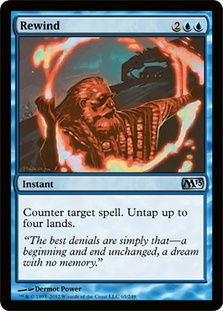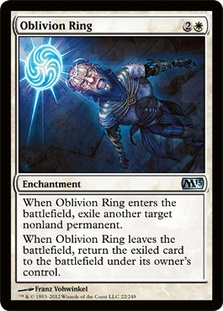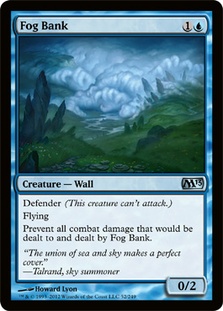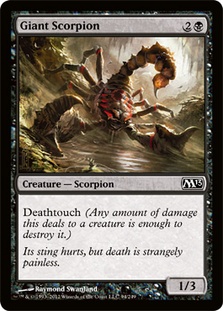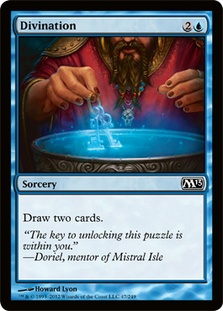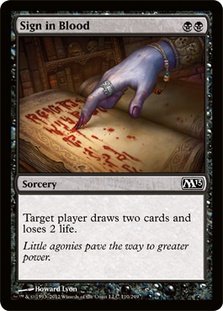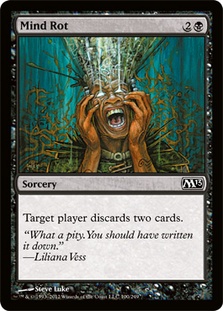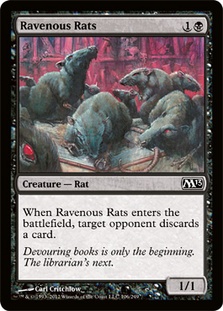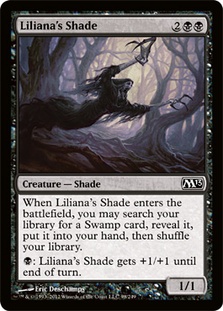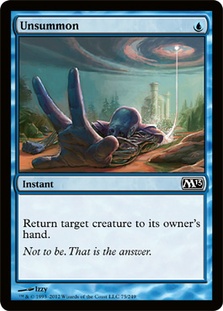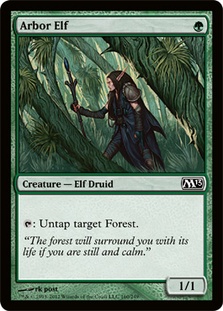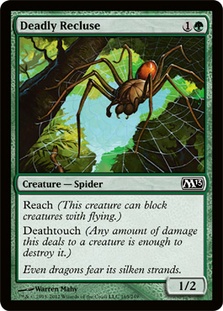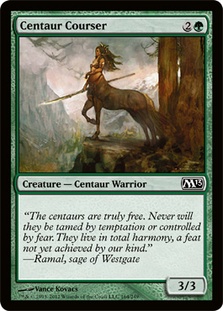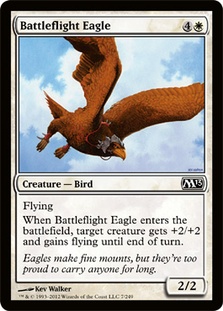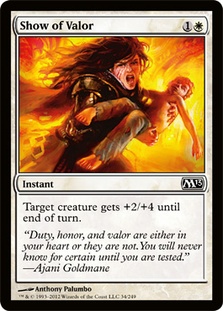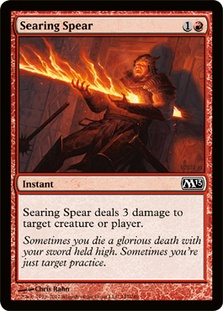I’ve long regarded core set Sealed Deck as my best and favorite format. This may seem strange, as players often argue that it’s the slowest and dullest among our tournament formats. Well, those players are exactly right, and that’s exactly the reason I love it so much! Nowhere else are the fundamental skills of Magic so important. Nowhere else will a good understanding of the game be so consistently rewarded. You cannot lean on a powerful Constructed deck or a talent for drafting. There’s simply no substitute for discipline in deck construction and wisdom in gameplay in core set Sealed.
Last weekend’s Prerelease is still fresh in my mind, and my impression is that M13 could prove to be my favorite Limited format among my favorite Limited formats! The four events I played certainly do not qualify me as an expert, but perhaps by combining my first impressions of the set with general Sealed Deck strategy, I can offer some helpful advice for this weekend’s release events.
Routes to Victory and Defeat
Through the millions of possibilities and card combinations across formats, I can boil down Sealed Deck games to a few categories based on the way the winner will be determined. There are a small handful of ways that the vast majority of Sealed Deck games end.
1. Unanswered Bomb
This is the one that tends to give core set Sealed a bad name. If a bomb goes unanswered, everything you read below this will not matter. It is the trump—the king of all ways for Limited games to end. While we’ve seen a few close-to-insurmountable bombs come and go over the years—Grave Titan and Gideon Jura come to mind—there’s plenty that you can do to make sure the "unanswered bomb" games are in your favor as often as possible.
From a deck construction standpoint, you should prioritize answers to bombs. Rewind, while not a tremendously efficient or powerful card in an objective sense, serves as an answer to nearly any opposing bomb if you play carefully. Having Rewind means that if you can put yourself in a winning situation, the game cannot be stolen from you by a single card. More obviously, Murder and Oblivion Ring should be big draws towards their respective colors.
You can also make an effort to include as many of your own bombs as possible. But don’t go overboard! Note that playing shallow colors or frivolously splashing will conflict with other advice I’ll give below. However, an example of when it’s smart to go out of your way for a bomb is when you’re deciding on your second color. Suppose you sort your cards and it’s very obvious that you should play green, because it’s deep and powerful. You need to choose a second color, but you’re not at risk of being short on playable cards. In such a situation, I’d rather choose blue if it had Jace, Memory Adept and not much else than choose red because it had Searing Spear, Turn to Slag, two Bladetusk Boars, and two Reckless Brutes. Red may have more cards that will be welcome additions to the deck, but what really matters is how large the improvement is over the other options. The red cards will only be marginal improvements over your green and blue filler, but Jace, Memory Adept is simply irreplaceable.
Sideboarding can also help. Look for the weaknesses your own deck has in the matchup and try to correct them. Look for the weaknesses in your opponent’s deck and try to attack them. Switching colors is not out of the question. Roundabout ways to answer an opposing bomb aren’t, either.
Most important, though, is gameplay. Playing around specific rares and mythics before seeing them is more trouble than it’s worth, but whenever possible you should play as though your opponent has a Serra Angel or Vampire Nighthawk in their hand (they usually do). Do you really need to spend removal on that creature? Or can you stall long enough to answer it in a different way? Remember that there’s always something scarier out there, so be stingy with your removal. Often, I’ll mentally set aside a card: "This Murder is for his Stormtide Leviathan and only for his Stormtide Leviathan." Then the only way I’ll Murder a creature is if it says Stormtide Leviathan at the top or if the game is going to end this turn anyway.
2. Mana Screw or Mana Flood
In the absence of a bomb, games will very often boil down to one player drawing an inconvenient number of lands: too few or too many. For more detailed coverage of this topic, you can consult last year’s article on M12 Limited which I wrote the week before making Top 8 of Grand Prix Montreal in the same format. How did I pull it off, you might ask? I didn’t get mana screwed or mana flooded! Lady Luck was certainly on my side in that regard and in general over the course of the tournament, but I’d also like to think I did everything I could to make her pick me on that particular weekend.
One way to minimize the chance of mana flood is to play fewer lands. One way to minimize the chance of mana screw is to build a deck that can operate on a small number of lands. See what I’m getting at? The savvy player can kill two birds with one stone! Prioritize cards that don’t cost a lot of mana but can trade with cards that do. Examples include Fog Bank, Giant Scorpion, Essence Scatter, Mind Rot, and of course, the premium removal spells.
Keep your deck to two colors unless you have the means and the motive for a comfortable splash. M13 happens to not have a lot of color fixing. In the four Sealed pools that I opened, splashing was not even a vague consideration. However, I did help one person with a pool where I advocated playing one main color with two splashes.
3. Card Advantage
You cannot control whether your opponents get mana screwed or mana flooded, so you should ask yourself how you can beat them assuming that they will not. You can’t do it by trading one for one, because eventually you yourself will inevitably begin to flood and be overwhelmed. Two for one advantages, though, will win you games where you and your opponents are on equal footing. They will also mitigate the effects of an unlucky mana flood. They are the bread and butter of core set Sealed.
Divination, Sign in Blood, and Mind Rot are direct, easy two for ones and are therefore awesome. Not only do I auto-include them; I consider them strong draws to their respective colors. That said, I would be irresponsible if I didn’t make it clear that I hold a very extreme opinion on these cards; many world-class players would not agree with my analysis. Between Divination and Mind Rot, Divination is substantially better, as it’s a good topdeck at any point in the game. However, Mind Rot has the added benefit of being a potential answer to an opposing bomb or a way to protect your own bomb—particularly against an opponent who doesn’t know or think to play around it.
Beyond Divination, Mind Rot, and a handful of others, you need to start being more creative. As always, look for opportunities in gameplay to turn combat tricks and utility cards into two-for-ones. Avoid creature enchantments, as they offer your opponents very easy two for ones. Avoid ineffectual cards like Tormented Soul, Warclamp Mastiff, and Downpour; they simulate card disadvantage by failing to generate a card’s worth of impact on the game. Note that Wild Guess is not card advantage and that Index is card disadvantage.
The Colors
In the four Sealed Deck Prerelease events I played in, I went U/B twice and G/B twice. The U/B decks were the better of the four—they had everything I look for in a deck. They had card advantage in the form of Mind Rot, Sign in Blood, Divination, Ravenous Rats, and Archaeomancer; they had answers to bombs in removal and permission; and they could operate on a small number of lands because of the way I could use card advantage and inexpensive cards to compete with more powerful individual spells.
Black
In Sign in Blood, Mind Rot, Ravenous Rats, and Liliana’s Shade, black has the most card advantage available at common. It also has Murder, the best common removal spell, alongside Essence Drain. Duress, Disentomb, and -1/-1 effects are also great tools but require a little more careful setup to be effective.
Black’s weakness is the fragility of its creatures. Even the powerful Liliana’s Shade is easy to kill and cannot block well the turn you play it. Giant Scorpion is a key tool for black decks because it helps to correct this weakness.
Blue
Divination and Archaeomancer are no slouches, and blue supports them with permission spells, which give you a lot of control and flexibility over how the game plays out.
Unsummon, though it’s somewhat contradictory to my card advantage philosophy, is a great card and I will always maindeck one when I can. If you’re patient, you can always find a way to get a card’s worth of value by rebuying an enters-the-battlefield effect, saving a creature, knocking off an aura, or killing a token. Alternatively, it can swing tempo in your favor, allowing you time to get maximum value from the rest of your cards.
Talrand’s Invocation and Fog Bank both looked great to me and proved to be even better than expected when I played with them! This could certainly change, but from my modest experience, blue is my favorite color in M13.
Green
Green does not have much direct card advantage, but it’s traditionally one of the best colors for Sealed Deck. The reason is that its creatures are so meaty and so good. When the game plays out your way, you can gain card advantage by quickly forcing your opponent to chump block or otherwise making them panic and use their cards in inefficient ways.
Above I used the phrase "one of the best colors," but it’s more precise to say that green is the "safest color" for Sealed Deck. If you can’t have removal, if you can’t have bombs, if you can’t have card advantage, at least you can have good creatures. Good creatures mean you’ll beat weak opponents, bad decks, and bad draws, and that can sometimes get you surprisingly far.
Arbor Elf, Deadly Recluse, Elvish Visionary, Centaur Courser, and Sentinel Spider are all great commons. Timberpack Wolf is not a standout card in Sealed, but it might prove to be in Draft.
White
White is historically my least favorite color in core set, but it’s not because its cards are bad. Quite the contrary, white tends to be the deepest in terms of the number of good commons, and M13 is no exception. It has both removal and solid creatures. The problem is that it does not provide the key things that I look for in core set Sealed. It offers no card advantage, and unless you have bombs, you might not have a reliable way to put away a game. Consequently, it’s very vulnerable to mana flood.
White’s creatures are efficient, but they do not individually dominate the board like green’s do so sometimes your whole army can be shut down by a single big blocker. Exalted helps a little bit with this problem in M13, but opens up the opposite problem of annoying chump blockers like Ravenous Rats and Elvish Visionary.
Battleflight Eagle and Show of Valor are not standout cards, but they can be integral to white decks because they allow you to keep attacking into opposing blockers.
Red
Like white, red does not offer card advantage or dominant creatures. What’s worse is that in M13, it is very shallow even in efficient creatures. Its saving grace is its absolutely incredible removal. Searing Spear, Turn to Slag, Volcanic Geyser, Flames of the Firebrand, Chandra’s Fury, and Arm’s Dealer are all remarkably powerful.
These factors combine to make red a support color. It simply does not have the creatures to do your heavy lifting, but giving an otherwise solid deck access to the burn spells listed above can really put you over the top.
I recommend against W/R as a color combination because of the lack of card advantage, unless your rares really give you no choice in the matter. G/R is a classic combination that always tends to be solid. U/R and B/R can also make for very good decks if things line up well. Make sure you have a realistic plan for winning the game, though it can be either controlling and landing a bomb or rushing down and finishing with burn.
The M13 format is still young, and I’ve hardly scratched the surface of what there is to know. There’s still two-color combinations, playing versus drawing, mulligans, deckbuilding, and gameplay decisions to discuss. And that’s not even to mention Draft! However, for the patient readers who’ve made it this far, I hope my opinions will help you in your own initial explorations of the format. I encourage you to keep what I’ve said in mind and use release weekend to put it to the test!

